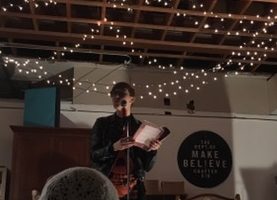Welcome to my first Weekly Update of the year. I post these because they provide a good way for me to hold myself accountable, both in terms of meeting my writing and reading goals, as well as making sure I post regularly on the blog.
Lately, there seems like there’s so much to write about, so much to resist and fight against, so much to do and say and act on that at times it feels overwhelming. Sometimes you can only do what you can do, so today, I’m going to talk about the Uptown Fridays event hosted by Nomadic Press that I attended a couple of Fridays ago, because it was wonderful and inspiring.
It was an interesting challenge getting to the event that night, involving an hour long car ride from my work to Oakland — only to find when I arrived that I had left my wallet back at the office, which meant that I had no cash or cards on hand to buy dinner or books from the reading. I considered returning to my office and coming back over the bridge (which would have made me late to the event), but decided to roll with it. Since I had an apple left in the car, I knew I wouldn’t starve and I let go of the idea of otherwise needing my wallet on hand. I let go and gave myself to enjoying the event I came for.
Thomas Nguyen performed a set of songs that were moving, some mixed with speeches and sounds from a tape recorder to wonderful effect. (He was also my hero of the night, reminding me of the toll on my return trip to work for my wallet and giving me a fiver to make it back without a wicked ticket.)
Isobel O’Hare read both from new work and from her chapbook The Garden Inside Her. I’ve known her from the online Facebook world for some time, so it was great to meet her in person. Her work is great and I’ll have to buy her chap the next time I get a chance.
Caits Meissner, whose work I’ve been following for years, was a delight to meet and hear read. She read both a new experimental piece that gave me chills and from her new book Let It Die Hungry. I was so grateful that my checkbook was in my purse, because it allowed me to buy Caits’ new book and have it signed. The book includes poems in both text and comic form — I can’t wait to read it.



For all the frustration of getting to the event and leaving my wallet behind, it was worth every bit of panic and frustration, because the night was a blessing. And it’s clear to me that I need to attend events like this more often, more events where people speak and address the world — both because it’s important to support artistic communities in times like this and because I find such experiences soothing to the soul.
What I’m Reading
My reading pace has been abysmally slow this month, has in fact been getting slower and slower over the course of the past year. I think this is partially because I’ve been reserving my lunchtime reading for getting some writing work done and because I’m too mentally distracted when I actually get home.
I’m currently working my way through Things We Lost in the Fire: Stories by Mariana EnrÃquez and Shadow Scale by Rachel Hartman, two very different books that I’m enjoying quite a bit. One is a collection of darkly beautiful short stories, the other is a novel about dragons.
If I finish on book this month, it will have to be Tim Burton: Essays on the Films by Johnson Cheu, because I’ve been working on it for several months now.
What I’m Writing
I have been off and on sticking to the 15 Minute Rule more or less over the past couple of weeks, especially during the last week when I launched into that wonderfully productive time of deadline panic. Poor Belly Press is closing for chapbooks in two days and I would love to have my Twelve Dancing Princesses chap picked up by them, because their chaps are so beautiful — which has lead me into desperately trying to edit and polish up my work in order to make the deadline. In fact, I should be getting off the blogging and back to work right now. (But allow me just a moment more.)
Goals for the Week:
- Finish chap edits and get it sent out
The Running Life
Since one of my goals is to actually accomplish a half marathon this year, I’ve decided to add running to my weekly updates.
I’ve been keeping with my routine of getting up hella early and making it to the gym two days a week for some short runs before work. These shorties are at about 25 minute, or 1.5-1.6 miles. Good small starts in preparation for the buildup, and they feel make me feel energized and cleansed in the morning. However, I have skipped my long weekend runs the last couple of weekends. I should be pressing past three miles into four miles at this point, but I’m dawdling.
Linky Goodness
I’ve been gathering links for weeks, so this is going to be a longish list.
In How To Keep Your March Momentum Going (regarding the amazing, inspiring event that was The Women’s March), Catherine Pearson recommends actions like signing up for e-mail updates from your local legislators and calling Congress daily.
“What comes next for the anti-Trump resistance will depend on how consistently these activists will engage and turn out for causes that are not their own; whether they’ll continue to phone their federal and state representatives after the inauguration and confirmation hearing hubbub dies down. It’s quite possible that what was started as an arguably superficial gesture at unity will evolve into one that holds the most powerful dissenters accountable for the least powerful,” writes Devon Maloney in Some Inconvenient Truths About The Women’s March On Washington.”But to do so, resisters must first reckon with complex issues of intersectionality.”
In Before You Celebrate The Zero Arrests At The Women’s March, Zeba Blay writes: “Of course, it is always a good thing when citizens are allowed to exercise their right to protest without anyone being harmed or detained. But there’s a question that should be asked and acknowledged, even as we celebrate the success of the protest:Would the outcome have been the same if the march had been exclusively organized by and mostly comprised of women of color?”
When You Brag That The Women’s Marches Were Nonviolent by Ijeoma Oluo.
How to survive in intersectional feminist spaces 101.
Alvin Chang describes how White America is quietly self-segregating, “Everyone wants diversity. But not everyone wants it on their street.”
20 Small Acts of Resistance You Can Do Today.
Celebration of women filmmakers triggers heated debate between Salma Hayek, Jessica Williams and Shirley MacLaine presents an interesting conversation between these women concerning issues of intersectionality in supporting women filmmakers.
_____




